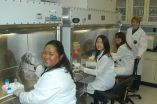Par4Success Offers Training for Golfers of All Ages with Titliest Performance Institute Professionals to Help Increase Swing Speed, Avoid Injury and Play Better Golf with Individualized Exercises
2014-04-22
Par4Success offers personalized workouts for golfers of all ages using Titliest Performance Institute (TPI) certified professionals and methods. TPI methods focus on helping a golfer develop an efficient golf swing that protects against potential injuries common in the sport. Using TPI methods along with other research based techniques typically reduces injuries while increasing swing speeds, thus helping the golfer improve their game with less risk of injury.
"All of our golf fitness professionals have either been certified by the Titliest Performance Institute and/or ...
Associate Tyler J. Moore Joins The Law Offices Of Mathys & Schneid
2014-04-22
The Law Offices of Mathys & Schneid, a Naperville, Illinois, personal injury law firm, is pleased to announce the addition of a second associate. Tyler J. Moore, a lifelong resident of the Chicago area, will devote his practice exclusively to civil litigation.
Mr. Moore joins partners Mark W. Mathys and Mark T. Schneid and associate Daniel R. Chaidez. The firm pursues justice for clients who have been injured or lost loved ones due to vehicle accidents, construction accidents, medical malpractice, product defects, and falls and other premises liability cases. The ...
Transform Your Smile and Optimize Your Comfort With Centurysmile Dental Technology
2014-04-22
Century Smile provides high quality general dental services in a relaxing environment that focuses on hygiene and comfort. Our experienced team will help you get a brilliant, white smile that improves your overall health and looks.
If you are looking for sparkling and dazzling smile, the team at Centurysmile has the experience, tools and technology to help you achieve it. Centurysmile provides an array of dental services including hygiene treatments, porcelain fillings, and crowns-services vital to maintaining a fresh and healthy smile.
With our expert Dentist like ...
MomsFightingAutism.com Presents 5th Online Autism Conference April 26th & 27th
2014-04-22
Moms Fighting Autism and Autism College are partnering up to offer a free virtual conference on Saturday April 26th and Sunday April 27th from 8:00 AM to 5:30 PM PST. This year's theme is: Autism from Adolescence to Adulthood, Preparing for Independence and Growth. Keynote speaker Chantal Sicile-Kira, author of five award-winning books on autism, will be speaking on Preparing for the Transition to Adulthood. Speakers include: Brian King, author of Strategies for Building Successful Relationships with People on the Autism Spectrum, who will speak on "Building a Support Community ...
Advanced Polymer Trading is to Exhibit at Interpack 2014 to Further Build its International Presence
2014-04-22
Advanced Polymer Trading, an international trading company specialising in the world wide trade of rubber and plastics, will be at Interpack 2014, one of the world's most important trade fairs for the packaging sector and related processing industries, which will be held from 8 May 2014 to 14 May 2014 in Dusseldorf, Germany.
This year's Interpack event will take up around 174,000 square metres of floor space and host around 2,700 exhibitors from a range of packaging related industries including food and beverages, confectionery and baked goods, pharmaceuticals and cosmetics, ...
Hampton Inn Gaffney SC Hotel Offers Special Rate for Guests Attending Alumni Weekend at Limestone College
2014-04-22
The Hampton Inn Gaffney South Carolina Hotel offers a special room rate of $115 per night to guests attending Alumni Weekend at Limestone College April 25-27, 2014. The Alumni Office has reserved a block of rooms. Alumni can reconnect with old friends and classmates as they attend special events throughout the weekend. The activities kick off on Friday evening with Shindig at the Cabin, a community concert in downtown Gaffney. The weekend continues with the Outstanding Alumni Awards Luncheon, Afternoon Tea, All Saints Reunion, campus tours, special exhibits, and Sunday ...
Hampton Inn & Suites Scottsboro Alabama Receives Prestigious Lighthouse Award
2014-04-22
The Hampton Inn & Suites Scottsboro AL Hotel is honored to receive the prestigious Lighthouse Award for 2013. This is the second consecutive year the hotel has won. The award is given annually to the top 5% of all Hampton Inn and Hampton Inn & Suites properties in North America, Puerto Rico, Costa Rica, Colombia, and Ecuador. The selections are based on quality scores from more than 1,800 of Hilton Worldwide's Hampton brands. The Scottsboro property is the #1 Hampton Inn & Suites in Alabama.
"We are pleased that our Hampton Inn & Suites hotel in Scottsboro ...
Hilton Garden Inn Columbia SC Northeast Receives Prestigious Success Award
2014-04-22
The Hilton Garden Inn Hotel in Columbia SC (Northeast) is honored to receive the prestigious 2013 Hotel Success Award by Hilton Worldwide. The award is given annually to the top 5% of Hilton Garden Inn brand properties in the US and Canada. The selections are based on quality scores in a number of strategic categories and overall guest service.
"We are pleased that our Hilton Garden Inn Columbia has been honored with the 2013 Hotel Success Award," explains Neel Shah, President of Hotel Evolution, the property's owner and management company. "Our local management team ...
Holiday Inn Express & Suites Newberry SC Hotel Offers Affordable Lodging for the SummerFun Horseshoe Tournament April 26-27, 2014
2014-04-22
The Holiday Inn Express & Suites Newberry SC Hotel offers affordable lodging to players and their families attending the SummerFun Horseshoe Tournament April 26-27, 2014. The annual Newberry event is the 2014 season opener on the Horseshoe Pitchers Pro Tour. The tournament is returning to Marion Davis Park in Newberry, South Carolina for the 6th consecutive year. The park has both indoor and outdoor courts, ensuring that the tournament will take place rain or shine. Many of the world's top competitors will be in town to participate.
"We look forward to welcoming ...
Jameson Inn Monroe NC Offers Convenient Lodging to Guests Attending 2014 Baccalaureate and Commencement at Wingate University
2014-04-22
Jameson Inn Monroe North Carolina Hotel offers convenient accommodations to guests attending upcoming graduation events at nearby Wingate University. The Baccalaureate service will be held on April 29 at noon. Commencement will take place on May 17 at 9am in the Academic Quadrangle of the main campus. Tickets are not required, and seating is first come, first served. In the event of inclement weather, the ceremony will be moved inside to Cuddy Arena. Parking will be available in all university lots.
"We are pleased to offer convenient lodging to guests attending the ...
Tampa Plumbing Services Experts at The Pampering Plumber Install Solar Pool Heating Systems to Decrease Costs and Increase Pool Time
2014-04-22
Most of us want to take a swim in our Tampa swimming pools whenever we can. Sadly, the weather in central Florida does not always allow for a midnight swim or a few laps in the wintertime.
Fortunately, the plumbers in Tampa, Fla., at The Pampering Plumber have an economical solution to keeping your pool warm. Solar pool heating systems heat your pool with the power of the Florida sunshine, decreasing operation costs over the life of the system.
In addition to greatly extending your available swimming season, solar pool heating systems are able to basically pay for ...
Pain Clinic Atlanta Spine & Alternative Pain Management Center Shares Signs and Symptoms of a Rotator Cuff Tear
2014-04-22
Comprised of a set of tendons and muscles in the shoulder, the rotator cuff connects the upper arm to the shoulder blade. Rotator cuff muscles make it possible for the shoulder to rotate, and rotator cuff tendons provide shoulder stability.
According to Atlanta Spine & Pain Management Center (ASAP), a noted spine center in Atlanta, pain from a rotator cuff tear can be felt over the outside of the shoulder and upper arm. Someone with a rotator cuff tear exhibits difficulty and feels pain raising their arms above their head or reaching behind their back. They have ...
Overhead Door Company of Tampa Discusses Summer Garage Door Maintenance
2014-04-22
The summer is one of the best times of the year to perform regular maintenance on your home, including your garage door. Overhead Door Tampa's technicians have several tips on how to properly maintain your garage this summer.
Your first step in tending to your Tampa overhead doors should be to wash away the grime that has accumulated on the door itself and its windows. Springtime in central Florida comes with heavy pollen counts, and your garage will inevitably be covered with seasonal gunk by the time summer rolls around. Simply use a mild household soap and water to ...
FindaFacilitator Discusses How to Choose the Right Strategic Planning Facilitator
2014-04-22
You know you need the assistance of a professional facilitator for your company's next strategic planning session, but how do you choose the right one?
FindaFacilitator has more than 500 meeting experts in their extensive database with varying degrees of experience and training in business facilitation. Simply fill out their "FindaFacilitator Fast" form to receive quick and reliable assistance from any one of their client relationship managers. You can be sure to find a certified facilitator that knows the nature of your business, is highly-trained, experienced, resourceful, ...
The Atlanta Electrical Contractors at Pat Murphy Electric Have Moved
2014-04-22
In an effort to provide improved service to its customers, Atlanta electrical contractor Pat Murphy Electric, Inc., has moved to a new location in Tucker, Ga.
For almost 20 years, Pat Murphy Electric, Inc., was located off of Mell Avenue in Atlanta. However, that space proved limited, and the residential electrical contractors realized that they would need more space in order to provide the best possible service to their customers. Their new location, located on Montreal Road in Tucker, offers twice the space of their former Mell Avenue location.
The new Pat Murphy ...
Windsor Foods Launches New Smartphone Application for Foodservice Industry
2014-04-22
Frozen foods company Windsor Foods is pleased to announce the release of the new Windsor Wheelhouse smartphone application aimed at delivering information on Windsor Foods products, specifications, and promotional materials directly to Apple and Android devices.
Available for download from Apple's App Store or Google Play, this free app gives users the ability to access a complete suite of product brochures, sell sheets, product and nutritional information, product specifications, coupons and much more. All of these components are instantly able to be viewed within ...
Track & Field News: World Bronze Medalist, Curtis Mitchell, becomes an ATP Extreme Sponsored Athlete
2014-04-22
ATP Nutritionals LLC, the makers of the revolutionary performance enhancing supplement ATP Extreme announced that elite track and field sprinter Curtis Mitchell recently joined their roster of Sponsored Athletes.
Curtis Mitchell is currently the top ranked 200m sprinter in the USA and recently brought home the 2013 World Championship Broze Medal from Moscow. Mitchell turned pro after his junior year of college at Texas A&M and never looked back.
According to Mitchell, "ATP Extreme has really taken my training to a new level. From my first day on the product, I ...
NationaLease Announces 4th Annual Tech Challenge Exam Regional Winners
2014-04-22
NationaLease is pleased to announce the regional winners of the fourth annual NationaLease Tech Challenge exam. This first step on the road to becoming the NationaLease Top Tech is a written exam which member company technicians completed in March. The regional winners go on to represent their member company in the next round of competition.
Each of the nine regional winners will participate in the hands-on competition, which will take place during the NationaLease Maintenance Managers Meeting this May, in Dallas, TX. The top three finalists in the competition will also ...
Race-Connection.com Launches Multi-Event, Revenue Generating Race Schedule App Targeting Dirt Track Racing
2014-04-22
Race-Connection.com, The world's only developer of Dirt Track Race Schedule Apps, are pleased to announce the launch of their IOS 7 based App on the Apple App Store. An example of this ground-breaking App can be downloaded to your iPhone today!
The Race Connection App is a powerful tool for any race event with Heats. It displays everything a race track or events needs to connect the guests to the action. This Reusable, Customizable, Revenue Generating App is easily updated to highlight your Track/Event Schedule, Drivers, Heat Participants, Heat Winners, Sponsors, Concession/Souvenir ...
Nouvola Wins Oregon Entrepreneurs Network's Top Angel Oregon Award
2014-04-22
Nouvola Inc., developer of cloud-based performance testing and predictive analytics solutions for mid-sized enterprises, today was named the most promising startup in Oregon by a panel of angel investors at the Oregon Entrepreneurs Network Angel Oregon 2014. Nouvola was awarded a cash prize of $250,000, chosen from 15 competing companies and an initial applicant pool of nearly 60 companies.
In October, Nouvola won the Bend Venture Conference grand prize of $250,000, which the company has used to advance its solution and deploy with a series of customers in various phases ...
Hawaii's First Artisan Roaster of Single-Estate Kona Coffee Launches Premier E-Commerce Site: KonaCoffeePurveyors.com
2014-04-22
Kona Coffee Purveyors announced today the launch of their e-commerce website purveying single-estate, high-elevation, artisan roasted Kona coffee for consumers worldwide.
"At Kona Coffee Purveyors, we seek out the most extraordinary crops of single-estate Kona coffee, and artisan roast each individual harvest to bring out its own unique characteristics," says Raymond Suiter, Founder and Master Roaster of Kona Coffee Purveyors. "Now discriminating coffee drinkers can, for the first time, experience the purity and beauty of Kona coffee from a company that is built upon ...
For an Immune Cell, Microgravity Mimics Aging
2014-04-22
Telling someone to "act your age" is another way of asking him or her to behave better. Age, however, does not always bring improvements. Certain cells of the immune system tend to misbehave with age, leaving the elderly more vulnerable to illness. Because these cells are known to misbehave similarly during spaceflight, researchers are studying the effects of microgravity on immune cells to better understand how our immune systems change as we age.
NASA and the National Institute on Aging, part of the National Institutes of Health, have teamed up to support research ...
Watch Former NFL Player Mark Walczak Sleep! Overnight Sleep Study at the American Sleep & Breathing Academy Conference Has Former AZ Cardinals NFL Player Mark Walczak Sleeping For A Cause
2014-04-22
Former Arizona Cardinals NFL player, and Pro-Player Health Alliance Sleep Apnea Awareness Advocate, Mark Walczak, undergoes a live public sleep study presented by the American Sleep and Breathing Academy to help raise awareness for sleep disorder treatment and education. ASBA's first public sleep study will be webcast alongside a clinical rotation for sleep health professionals and will be open for observation by registered attendees of the American Sleep & Breathing Academy's Sleep and Wellness 2014: A Conference for Healthcare Professionals, held at the Radisson Ft. ...
CT measures potentially dangerous arterial plaque in diabetic patients
2014-04-22
OAK BROOK, Ill. – Imaging of the coronary arteries with computed tomography (CT) angiography provides an accurate assessment of arterial plaque and could have a dramatic impact on the management of diabetic patients who face a high risk of heart attacks and other cardiovascular events, according to a new multicenter study published online in the journal Radiology.
Plaque that forms in the arterial walls can restrict blood flow and, in some cases, rupture, leading to potentially fatal heart attacks. There is considerable evidence that calcified, or stable, plaque, is less ...
Acute respiratory distress syndrome: Study IDs surgical patients at risk
2014-04-22
ROCHESTER, Minn. — Acute respiratory distress syndrome is a leading cause of respiratory failure after surgery. Patients who develop the lung disorder postoperatively are at higher risk of dying in the hospital, and those who survive the syndrome may still bear its physical effects years later. A Mayo Clinic-led study is helping physicians better identify patients most at risk, the first step toward preventing this dangerous and costly surgical complication. They found nine independent risk factors, including sepsis, high-risk aortic vascular surgery, high-risk cardiac ...
[1] ... [3559]
[3560]
[3561]
[3562]
[3563]
[3564]
[3565]
[3566]
3567
[3568]
[3569]
[3570]
[3571]
[3572]
[3573]
[3574]
[3575]
... [8705]
Press-News.org - Free Press Release Distribution service.











